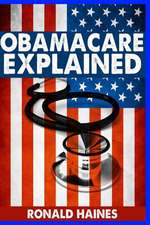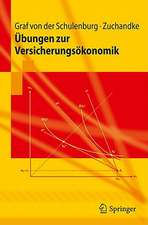Mathematical and Statistical Methods for Actuarial Sciences and Finance
Editat de Cira Perna, Marilena Sibilloen Limba Engleză Hardback – 24 mar 2014
| Toate formatele și edițiile | Preț | Express |
|---|---|---|
| Paperback (2) | 564.46 lei 38-44 zile | |
| Springer – 29 noi 2013 | 564.46 lei 38-44 zile | |
| Springer International Publishing – 23 aug 2016 | 635.80 lei 6-8 săpt. | |
| Hardback (2) | 559.99 lei 38-44 zile | |
| Springer International Publishing – 24 mar 2014 | 559.99 lei 38-44 zile | |
| Springer – 6 oct 2011 | 903.17 lei 6-8 săpt. |
Preț: 559.99 lei
Preț vechi: 699.98 lei
-20% Nou
Puncte Express: 840
Preț estimativ în valută:
107.15€ • 112.18$ • 88.66£
107.15€ • 112.18$ • 88.66£
Carte tipărită la comandă
Livrare economică 01-07 aprilie
Preluare comenzi: 021 569.72.76
Specificații
ISBN-13: 9783319050133
ISBN-10: 3319050133
Pagini: 200
Ilustrații: X, 190 p. 26 illus., 7 illus. in color.
Dimensiuni: 155 x 235 x 17 mm
Greutate: 0.41 kg
Ediția:2014
Editura: Springer International Publishing
Colecția Springer
Locul publicării:Cham, Switzerland
ISBN-10: 3319050133
Pagini: 200
Ilustrații: X, 190 p. 26 illus., 7 illus. in color.
Dimensiuni: 155 x 235 x 17 mm
Greutate: 0.41 kg
Ediția:2014
Editura: Springer International Publishing
Colecția Springer
Locul publicării:Cham, Switzerland
Public țintă
ResearchCuprins
1 I. Albarrn, P. Alonso, A.Arribas-Gil and A. Gran: Can personal dependency paths help to estimate life expectancy free of dependency?.- 2 A. Amendola and V. Candila: Evaluation of volatility forecasts in a VaR framework.- 3 A. Amendola and M. Restaino: Optimal cut-off points for multiple causes of business failure models.- 4 R. Baragona, F. Battaglia and D. Cucina: Maximum empirical likelihood inference for outliers in autoregressive time series.- 5 A. Basso and S. Funari: The role of fund size and returns to scale in the performance of mutual funds.- 6 M. Biancardi and G. Villani: A robustness analysis of least-squares monte carlo for r&d real options valuation.- 7 G. Bimonte and P. Spennati: The common pool problem of intergovernmental interactions and fiscal discipline: a Stackelberg approach.- 8 S. Boffelli and G. Urga: High -and low-frequency correlations in European government bond spreads and their macroeconomic drivers.- 9 S. Bonini and G. Caivano: Probability of default: a modern calibration approach.- 10 S. Bonini and G. Caivano: Development of a LGD model Basel2 compliant: a case study.- 11 S. Capecchi and D. Piccolo: Modelling the latent components of personal happiness.- 12 M. Caporin, L. Corazzini and M. Costola: Measuring the impact of behavioural choices on the market prices.- 13 M. Cardin: A note on natural risk statistics, OWA operators and generalized Gini functions.- 14 R. Cerchiara and V. Magatti: The estimation of standard deviation of premium risk under solvency 2. - 15 M. Coppola and V. D'Amato: The solvency capital requirement management for an insurance company.- 16 M. Corduas: Direct multi-step estimation and time series classification. - 17 V. D'Amato, S. Haberman, G. Piscopo and M. Russolillo: Alternative Assessments of the Longevity Trends.- 18 G. H. Dash, Jr. and N. Kajiji: Combinatorial nonlinear goal programming for ESG portfolio optimization and dynamic hedge management.- 19 A. Di Crescenzo, B. Martinucci and S. Zacks:On the geometric Brownian motion with alternating trend.- 20 E. Di Lorenzo, M. La Rocca, A. Orlando, C. Perna and M. Sibillo: Empirical evidences on predictive accuracy of survival models.- 21 R. Donati and M. Corazza: RedESTM, a risk measure in a Pareto-Levy stable framework with clustering.- 22 N. Ettore D'Ortona and G. Melisi: Run-off error in the outstanding claims reserves evaluation.- 23 S. Ferrando, A. Gonzalez, I. Degano, and M. Rahsepar: Trajectory based market models. Arbitrage and pricing intervals.- 24 G. Fig-Talamanca: A statistical test for the Heston model.- 25 F. Giordano, M. Niglio and C. Damiano Vitale: Threshold Random Walk structures in finance.- 26 J. Gogola: Stochastic mortality models. Application to CR mortality data.- 27 M. Harcek: Risk adjusted dynamic hedging strategies.- 28 A. Klani and F. Quittard-Pinon: Pricing and hedging variable annuities.- 29 D. G. Konstantinides and C. E. Kountzakis: Monetary risk functionals on Orlicz spaces produced by set-valued risk maps and random measures.- 30 N. Loperfido: A probability inequality related to Mardia's kurtosis.- 31 G. M. Mantovani, G. Coro, P. Gurisatti and M. Mestroni: Integrating industrial and financial analysis into a rating methodology for corporate risk detection: the case of the Vicenza manufacturing firms.- 32 L. Mercuri and E. Rroji: Risk measurement using the mixed tempered stable distribution.- 33 M. Mestroni, E. Basilico and G. Max Mantovani: Corporate finance... what else? The case of the productive chain networks in north-east Italy and the scaffolding finance adopted by their leader.- 34 A. Naccarato and P. Andrea: BEKK element-by-element estimation of a volatility matrix. A portfolio simulation.- 35 M. Nardon and P. Pianca: The effects of curvature and elevation of the probability weighting function on options prices.- 36 A. Ntamjokouen, S. Haberman and G. Consigli: A multivariate approach to project the long run relationship of mortality indices between Canadianprovinces.- 37 A. Orlando, G. di Lorenzo and M. Politano: Measuring and managing the longevity risk: an empirical evidence from the Italian pension market.- 38 T. Paletta, A. Leccadito and R. Tunaru: Pricing and hedging basket options under shifted asymmetric jump-diffusion process.- 39 M. Resta: On a data mining framework for the identification of frequent pattern trends.- 40 D. Teneng and K. Parna: Risk processes with normal inverse gaussian claims and premiums.- 41 T. Uratani: A portfolio model for the risk management in public pension.- 42 R. Yves: Black Scholes option sensitivity using high order greeks.
Textul de pe ultima copertă
The interaction between mathematicians and statisticians working in the actuarial and financial fields is producing numerous meaningful scientific results. This volume, comprising a series of four-page papers, gathers new ideas relating to mathematical and statistical methods in the actuarial sciences and finance.
The book covers a variety of topics of interest from both theoretical and applied perspectives, including: actuarial models; alternative testing approaches; behavioral finance; clustering techniques; coherent and non-coherent risk measures; credit-scoring approaches; data envelopment analysis; dynamic stochastic programming; financial contagion models; financial ratios; intelligent financial trading systems; mixture normality approaches; Monte Carlo-based methodologies; multicriteria methods; nonlinear parameter estimation techniques; nonlinear threshold models; particle swarm optimization; performance measures; portfolio optimization; pricing methods for structured and non-structured derivatives; risk management; skewed distribution analysis; solvency analysis; stochastic actuarial valuation methods; variable selection models; and time series analysis tools.
This book will be of value for academics, PhD students, practitioners, professionals, and researchers. It will also be of interest to other readers with some quantitative background knowledge.
The book covers a variety of topics of interest from both theoretical and applied perspectives, including: actuarial models; alternative testing approaches; behavioral finance; clustering techniques; coherent and non-coherent risk measures; credit-scoring approaches; data envelopment analysis; dynamic stochastic programming; financial contagion models; financial ratios; intelligent financial trading systems; mixture normality approaches; Monte Carlo-based methodologies; multicriteria methods; nonlinear parameter estimation techniques; nonlinear threshold models; particle swarm optimization; performance measures; portfolio optimization; pricing methods for structured and non-structured derivatives; risk management; skewed distribution analysis; solvency analysis; stochastic actuarial valuation methods; variable selection models; and time series analysis tools.
This book will be of value for academics, PhD students, practitioners, professionals, and researchers. It will also be of interest to other readers with some quantitative background knowledge.
Caracteristici
Improves the quality of the scientific results of financial and insurance problems using mathematical and statistical tools Allows a quick consultation The book is a meaningful survey of interesting and updated ideas in the field Includes supplementary material: sn.pub/extras




























